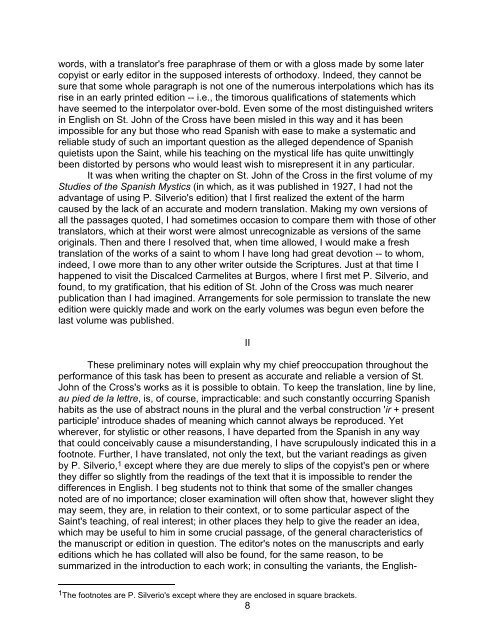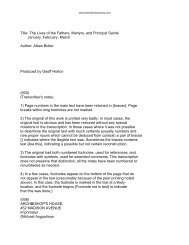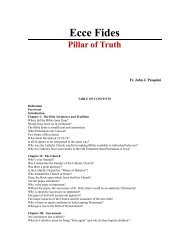Ascent of Mt. Carmel - St. Patrick's Basilica
Ascent of Mt. Carmel - St. Patrick's Basilica
Ascent of Mt. Carmel - St. Patrick's Basilica
Create successful ePaper yourself
Turn your PDF publications into a flip-book with our unique Google optimized e-Paper software.
words, with a translator's free paraphrase <strong>of</strong> them or with a gloss made by some later<br />
copyist or early editor in the supposed interests <strong>of</strong> orthodoxy. Indeed, they cannot be<br />
sure that some whole paragraph is not one <strong>of</strong> the numerous interpolations which has its<br />
rise in an early printed edition -- i.e., the timorous qualifications <strong>of</strong> statements which<br />
have seemed to the interpolator over-bold. Even some <strong>of</strong> the most distinguished writers<br />
in English on <strong>St</strong>. John <strong>of</strong> the Cross have been misled in this way and it has been<br />
impossible for any but those who read Spanish with ease to make a systematic and<br />
reliable study <strong>of</strong> such an important question as the alleged dependence <strong>of</strong> Spanish<br />
quietists upon the Saint, while his teaching on the mystical life has quite unwittingly<br />
been distorted by persons who would least wish to misrepresent it in any particular.<br />
It was when writing the chapter on <strong>St</strong>. John <strong>of</strong> the Cross in the first volume <strong>of</strong> my<br />
<strong>St</strong>udies <strong>of</strong> the Spanish Mystics (in which, as it was published in 1927, I had not the<br />
advantage <strong>of</strong> using P. Silverio's edition) that I first realized the extent <strong>of</strong> the harm<br />
caused by the lack <strong>of</strong> an accurate and modern translation. Making my own versions <strong>of</strong><br />
all the passages quoted, I had sometimes occasion to compare them with those <strong>of</strong> other<br />
translators, which at their worst were almost unrecognizable as versions <strong>of</strong> the same<br />
originals. Then and there I resolved that, when time allowed, I would make a fresh<br />
translation <strong>of</strong> the works <strong>of</strong> a saint to whom I have long had great devotion -- to whom,<br />
indeed, I owe more than to any other writer outside the Scriptures. Just at that time I<br />
happened to visit the Discalced <strong>Carmel</strong>ites at Burgos, where I first met P. Silverio, and<br />
found, to my gratification, that his edition <strong>of</strong> <strong>St</strong>. John <strong>of</strong> the Cross was much nearer<br />
publication than I had imagined. Arrangements for sole permission to translate the new<br />
edition were quickly made and work on the early volumes was begun even before the<br />
last volume was published.<br />
1The footnotes are P. Silverio's except where they are enclosed in square brackets.<br />
8<br />
II<br />
These preliminary notes will explain why my chief preoccupation throughout the<br />
performance <strong>of</strong> this task has been to present as accurate and reliable a version <strong>of</strong> <strong>St</strong>.<br />
John <strong>of</strong> the Cross's works as it is possible to obtain. To keep the translation, line by line,<br />
au pied de la lettre, is, <strong>of</strong> course, impracticable: and such constantly occurring Spanish<br />
habits as the use <strong>of</strong> abstract nouns in the plural and the verbal construction 'ir + present<br />
participle' introduce shades <strong>of</strong> meaning which cannot always be reproduced. Yet<br />
wherever, for stylistic or other reasons, I have departed from the Spanish in any way<br />
that could conceivably cause a misunderstanding, I have scrupulously indicated this in a<br />
footnote. Further, I have translated, not only the text, but the variant readings as given<br />
by P. Silverio, 1 except where they are due merely to slips <strong>of</strong> the copyist's pen or where<br />
they differ so slightly from the readings <strong>of</strong> the text that it is impossible to render the<br />
differences in English. I beg students not to think that some <strong>of</strong> the smaller changes<br />
noted are <strong>of</strong> no importance; closer examination will <strong>of</strong>ten show that, however slight they<br />
may seem, they are, in relation to their context, or to some particular aspect <strong>of</strong> the<br />
Saint's teaching, <strong>of</strong> real interest; in other places they help to give the reader an idea,<br />
which may be useful to him in some crucial passage, <strong>of</strong> the general characteristics <strong>of</strong><br />
the manuscript or edition in question. The editor's notes on the manuscripts and early<br />
editions which he has collated will also be found, for the same reason, to be<br />
summarized in the introduction to each work; in consulting the variants, the English-






